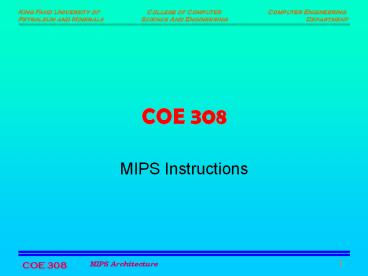MIPS Instructions - PowerPoint PPT Presentation
Title:
MIPS Instructions
Description:
COE 308 MIPS Instructions MIPS Instructions in MIPS Reduced Instruction Set 3 Operands per operation: 2 sources and 1 destination Most instructions are of the form ... – PowerPoint PPT presentation
Number of Views:401
Avg rating:3.0/5.0
Title: MIPS Instructions
1
COE 308
- MIPS Instructions
2
MIPS
Microprocessor without Interlocked Pipeline
Stages
- RISC microprocessor architecture developed by
MIPS Computer Systems Inc. - MIPS designs are used in SGI's computer product
line, and have found broad application in
embedded systems, Windows CE devices, and Cisco
routers. - The Nintendo 64 console, Sony Playstation
console, Sony Playstation 2 console, and Sony
Playstation Portable handheld system use MIPS
processors. - By the late 1990s it was estimated that one in
three RISC chips produced were MIPS-based
designs.
3
Instructions in MIPS
- Reduced Instruction Set
- 3 Operands per operation 2 sources and 1
destination - Most instructions are of the form
Operation dst, src1, src2 Where it means dst ?
src1 Operation src2 Example addition add dst,
src1, src2 means dst ? src1 src2
4
Operands
- 32 General-purpose registers R0 R31
- R0 is wired to the value 0
- Writing to R0 does not change its value
- Special-purpose registers LO and HI
- Hold results of integer multiply and divide
- Special-purpose program counter PC
- 32 Floating Point Registers (FPRs)
- Floating Point Unit (FPU) can be either 32-bit or
64-bit - FPRs are 32 bits on a 32-bit FPU, and 64 bits on
a 64-bit FPU - Almost all instructions operate on registers
- All destination operands are registers
- One of the source operands is a signed/unsigned
16-bits immediate value
5
Instruction Format
- Fixed Format
- 3 Format Types
- Register R-type
- Immediate I-type
- PC-relative J-type
6 bits
6 bits
5 bits
5 bits
5 bits
5 bits
All MIPS Instructions Format
6
R-Type
op
funct
rs
rt
rd
shamt
6 bits
6 bits
5 bits
5 bits
5 bits
5 bits
- Used by
- Arithmetic Instructions
- Logic Instructions
- Except when Immediate Addressing mode used
7
I-Type
op
rs
rt
address/immediate
6 bits
5 bits
5 bits
16 bits
- Used by
- Instructions using Immediate addressing mode
- Instructions using Displacement addressing mode
- Branch instructions
8
J-Type
op
target address
6 bits
26 bits
- Used by
- Jump Instructions
9
Instructions
- Arithmetic and Logic Instructions
- Comparison Instructions
- Load/Store and Data Movement Instructions
- Branch and Jump Instructions
10
Arithmetic Logic Instructions
- small circle in front of the instruction means
that it is a pseudo-instruction
11
Addressing Modes
- The second operand of all of the load and store
instructions must be an address. The MIPS
architecture supports the following addressing
modes
12
Load Instructions
13
Store Instructions
14
Data Movements Instructions
- The data movement instructions move data among
registers. Special instructions are provided to
move data in and out of special registers such as
hi and lo.
15
Exceptions
16
Assembly Conventions
17
Comments, Labels, Registers and Directives
- Comment
- Label
- ltlabelgt
- Registers
- ltregister_numbergt or ltregister_labelgt
- Directives
- .data for defining the constant segment
- .text for defining the code
- .ascii for defining strings
- .asciiz for defining zero-terminated strings
- .byte for defining constants
18
Registers
Even though any of the registers can
theoretically be used for any purpose, MIPS
programmers have agreed upon a set of guidelines
that specify how each of the registers should be
used. Programmers (and compilers) know that as
long as they follow these guidelines, their code
will work properly with other MIPS code.
19
SPIM Simulator
Source code text file saved as with .asm
extension.































